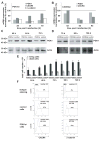Phosphoglycerate kinase 1 a promoting enzyme for peritoneal dissemination in gastric cancer
- PMID: 19688824
- PMCID: PMC2811232
- DOI: 10.1002/ijc.24835
Phosphoglycerate kinase 1 a promoting enzyme for peritoneal dissemination in gastric cancer
Abstract
Peritoneal carcinomatosis is a frequent finding in gastric cancer associated with a poor prognosis. The features that enable gastric tumors to disseminate are poorly understood until now. Previously, we showed elevated mRNA levels of phosphoglycerate kinase 1 (PGK1), an adenosine triphosphate-generating enzyme in the glycolytic pathway, the chemokine receptor 4 (CXCR4), the corresponding chemokine ligand 12 (CXCL12) and beta-catenin in specimens from gastric cancer patients with peritoneal carcinomatosis. In this study, the influence of PGK1 on CXCR4 and beta-catenin was assessed as well as the invasiveness of PGK1 overexpressing cancer cells. In this current study, we found that PGK1 regulates the expression of CXCR4 and beta-catenin at the mRNA and protein levels. On the other hand, CXCR4 regulates the expression of PGK1. Plasmid-mediated overexpression of PGK1 dramatically increased the invasiveness of gastric cancer cells. Interestingly, inhibition of CXCR4 in cells overexpressing PGK1 produced only a moderate reduction of invasiveness suggesting that, PGK1 itself has a critical role in tumor invasiveness. Immunohistochemistry in specimens from diffuse gastric cancer patients also revealed an overexpression of PGK1 in patients with development of peritoneal carcinomatosis. Therefore, PGK1 may be a crucial enzyme in peritoneal dissemination. Together these findings suggest that the enhanced expression of PGK1 and its signaling targets CXCR4 and beta-catenin in gastric cancer cells promote peritoneal carcinomatosis. Thus, PGK1 may serve as prognostic marker and/or be a potential therapeutic target to prevent dissemination of gastric carcinoma cells into the peritoneum.
Conflict of interest statement
The authors declare no conflict of interest or conflicting financial interests.
Figures





References
-
- Parkin DM, Pisani P, Ferlay J. Global cancer statistics. CA Cancer J Clin. 1999;49:33–64. - PubMed
-
- Yasumoto K, Koizumi K, Kawashima A, Saitoh Y, Arita Y, Shinohara K, Minami T, Nakayama T, Sakurai H, Takahashi Y, Yoshie O, Saiki I. Role of the CXCL12/CXCR4 axis in peritoneal carcinomatosis of gastric cancer. Cancer Res. 2006;66:2181–7. - PubMed
-
- Bando E, Yonemura Y, Takeshita Y, Taniguchi K, Yasui T, Yoshimitsu Y, Fushida S, Fujimura T, Nishimura G, Miwa K. Intraoperative lavage for cytological examination in 1,297 patients with gastric carcinoma. Am J Surg. 1999;178:256–62. - PubMed
-
- Zieker D, Konigsrainer I, Traub F, Nieselt K, Knapp B, Schillinger C, Stirnkorb C, Fend F, Northoff H, Kupka S, Brucher BL, Konigsrainer A. PGK1 a potential marker for peritoneal dissemination in gastric cancer. Cell Physiol Biochem. 2008;21:429–36. - PubMed
-
- Wang J, Wang J, Dai J, Jung Y, Wei CL, Wang Y, Havens AM, Hogg PJ, Keller ET, Pienta KJ, Nor JE, Wang CY, et al. A glycolytic mechanism regulating an angiogenic switch in prostate cancer. Cancer Res. 2007;67:149–59. - PubMed
Publication types
MeSH terms
Substances
Grants and funding
LinkOut - more resources
Full Text Sources
Medical
Miscellaneous

